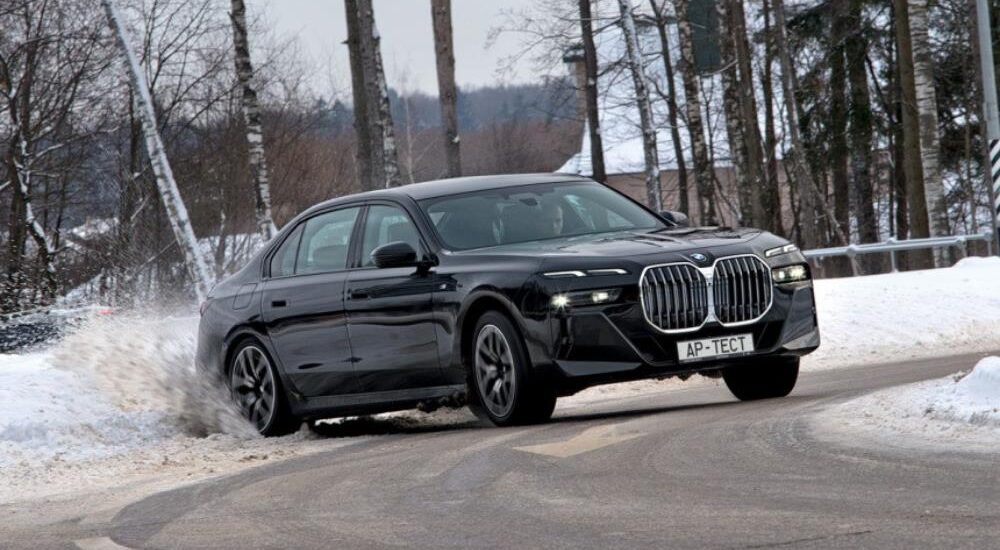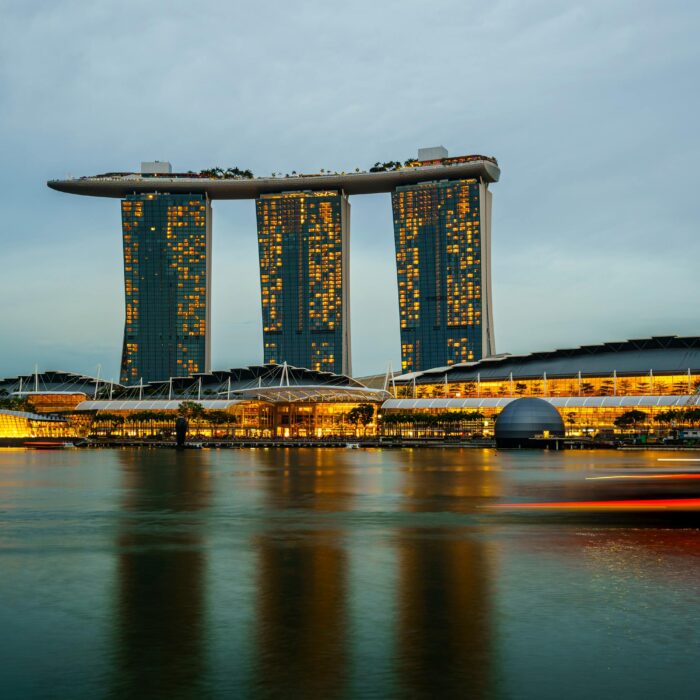Görünüşe göre şu anda yeni BMW 7 Serisi’nin tasarımına ilişkin görüşümü yeniden değerlendiriyorum. İlk inkarım ilk otuz dakika içinde kayboldu ve ardından sürüş hayal kırıklığıyla dolu bir gün geldi. Şimdi, marka videolarını, arızaları ve otomotiv tasarımcılarının yorumlarını tekrar tekrar izledikten sonra, stilini çarpıcı bulmakta hala tereddüt ediyorum, ancak kabul etmeyi öğrendim. Yine de, G70 sedan, salt estetiğin ötesine geçen şekillerde şaşırtıyor.
Yaygın eleştiriler bir şeyi çevrelediğinde, beni daha derinlemesine keşfetmeye ve kendi fikrimi oluşturmaya teşvik ediyor. Bu, tam olarak yeni 7 Serisi’nin yaygın olarak benimsenmeyen tasarımıyla ilgili deneyimimdi. Yine de, artık belirgin burun delikleriyle BMW M4’ü kabul ediyoruz ve bir zamanlar eleştirilen E60 5 Serisi klasik statüsüne yaklaşıyor. Belki de bu sedan da biraz zamanı hak ediyor. Bu yaklaşım, 7 Serisi E65 nesli hariç her durumda etkili olduğunu kanıtladı. Ben önceden bu listeye iX ve XM crossover’larını ekleyeceğim; bu modellerin güzellikleri için saygı gördüğünü görmeye yetecek kadar uzun yaşayamayabiliriz.
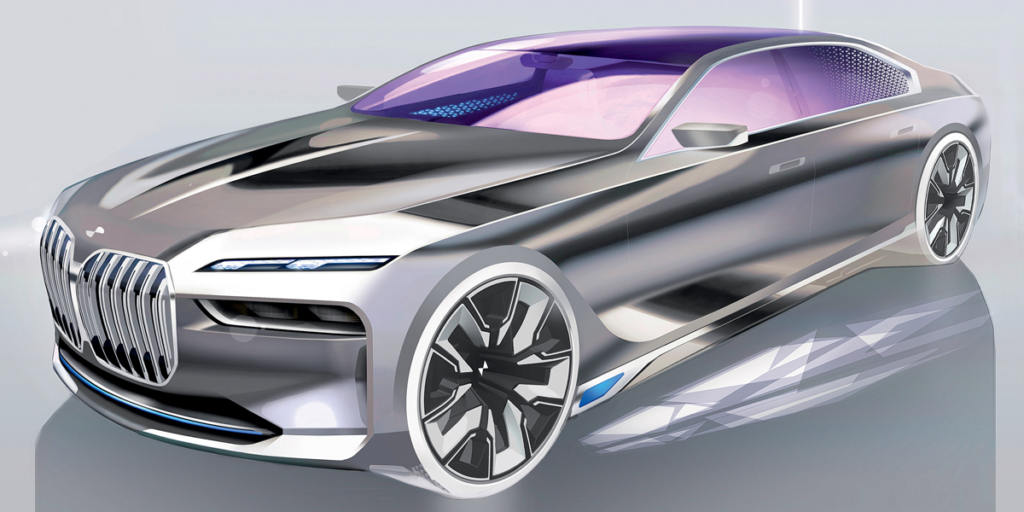
G70 sedan’ın tasarımı yalnızca Domagoj Dukec ve Sebastian Simm’in değil, aynı zamanda 2017’den 2019’a kadar BMW’de bulunan Josef Kaban’ın da eseriydi. Her zamanki gibi, tasarımcıların ilk vizyonu biraz farklıydı: eskizlerde, gelecekteki “7 serisi” çok kısa bir ön çıkıntı ve kompakt bir bagajla daha dinamik bir silüete sahipti. Ancak, iki katmanlı optiklere sahip yüz, projede en başından beri vardı – şimdi X7 ve XM dahil olmak üzere tüm kıdemli BMW’lerin ayırt edici bir özelliği.
İlk ve en çarpıcı izlenim boyutu. Yeni 7 Serisi büyük hissettiriyor, uzunluk olarak değil -çünkü artık kısa dingil mesafesine sahip versiyonlar yok- ama yükseklik olarak. Yanında durduğunuzda, pencere çizgisinin de crossover benzeri bir yüksekliğe ulaştığı bir Aurus’un yanında durmaya benzer bir his uyandırıyor. Önceki 7 Serisi ile karşılaştırdığımda, pencerelerin artık 8 cm daha yüksekte başladığını fark ettim. Bu değişiklik büyük ölçüde BMW’nin hem hidrokarbon hem de elektrikli modeller için birleşik bir platform kullanma stratejik kararından kaynaklanıyor, Mercedes ise akülü araçlarını farklılaştırmayı tercih ediyor.
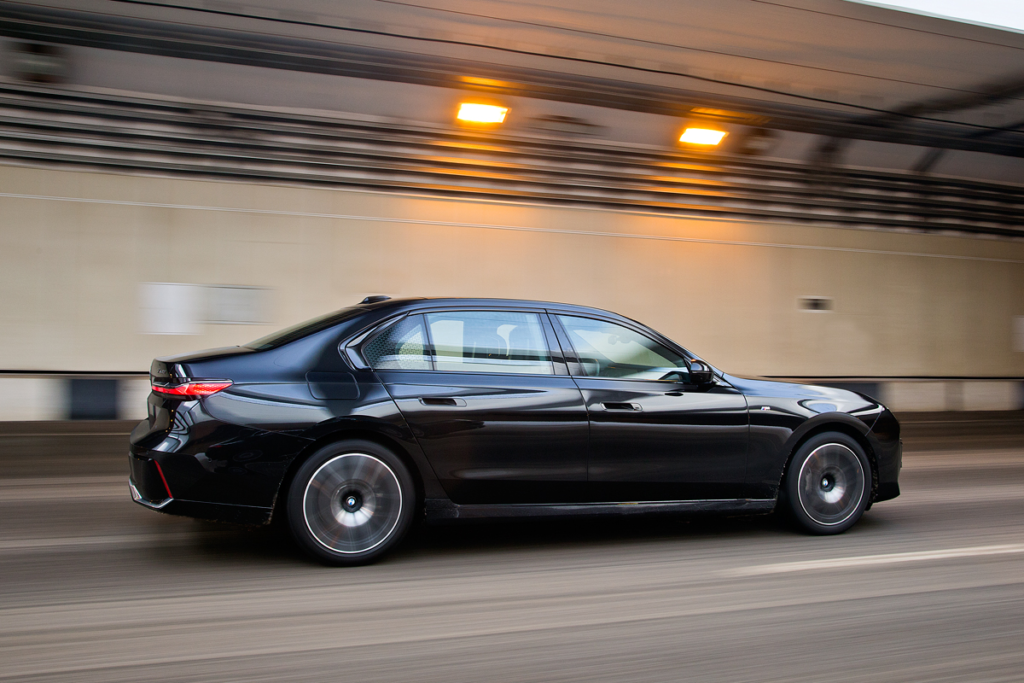
7 Serisi daha önce hiç bu kadar çeşitli güç aktarma organları sunmamıştı: hafif hibritlerden ve plug-in hibritlerden geleneksel dizel ve saf elektrikli tahriklere. 660 beygir gücüne kadar çıkabilen elektrikli BMW i7 sedan, şüphesiz birçok kişi için ilgi çekici. Ancak, bayi tarafından sağlanan tek dizel modeli olan BMW 740d xDrive’ı test etme şansına eriştim. Bu model, 286 beygir gücü sağlayan üç litrelik turbo dizel B57 motora sahip ve 48 voltluk bir marş jeneratörüyle birleştirildiğinde toplam 299 beygir gücü ve 670 Newton-metre tork üretiyor. Bu, yeni serideki tek dizel varyantı olmaya devam ediyor.
BMW 740d gösterişli seçeneklerden kaçınıyor: Swarovski kristal farlar yok, kapı servoları yok ve kesinlikle arka yolcular için devasa 31 inçlik “televizyon” yok. Ancak sorun değil; test süremiz gün ışığıyla sınırlı. Günümüzde her “elektro-Çin” arabası anlamsızca kapıları fırlatabilir ve tavana monte edilmiş bir “televizyon”… Dev bir ekranı hareket halinde izlerken mide bulantısı hissetmeniz ne kadar sürecek? Zilleri ve düdükleri bir kenara bırakalım ve gerçekten önemli olana odaklanalım.
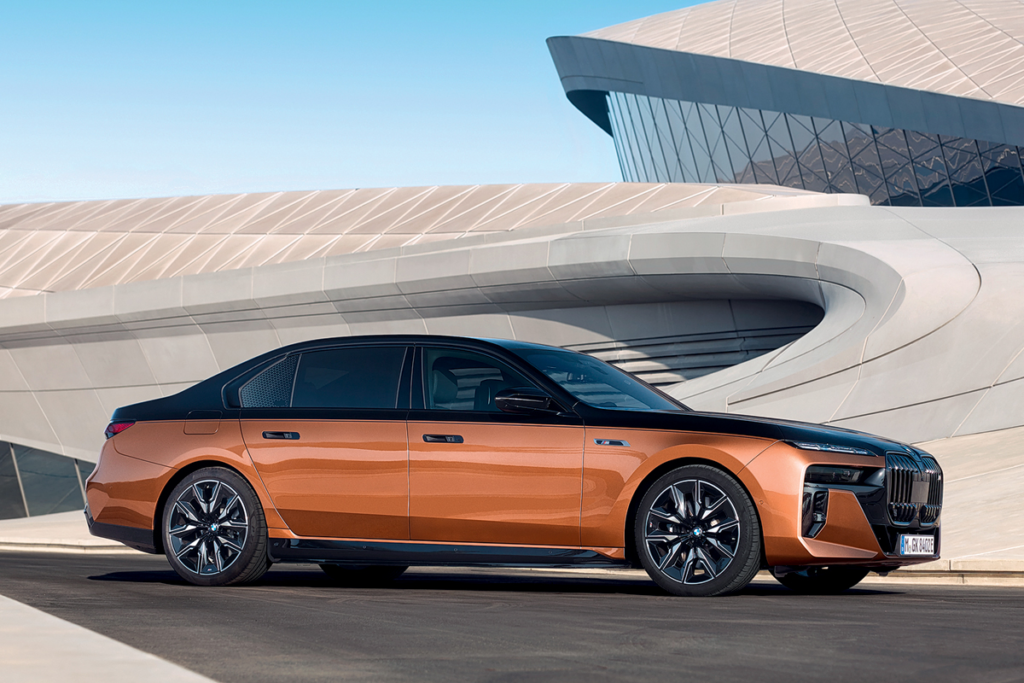
Dizel versiyonu 740d xDrive’ın yanı sıra, G70 ailesi birçok başka varyantı da içerir. Tamamen benzinli BMW 735i (3.0 L, 286 bg), 740i (3.0 L, 380 bg) ve 760i xDrive (4.4 L, 544 bg) yalnızca ihracat için üretilir – esas olarak Amerika ve Çin için. Avrupa’ya, elektrikli bir motorla birlikte çalışan üç litrelik benzinli “altı”ya sahip plug-in hibrit BMW 750e xDrive (489 bg) ve M760e xDrive (571 bg) tahsis edilmiştir. Ayrıca, dışarıdan yakıtlı “7 serisi”nden neredeyse ayırt edilemeyen üç elektrikli BMW i7 (ilk slayt) vardır: eDrive50 versiyonu (455 bg) arka aksta tek bir motora sahipken, xDrive60 (544 bg) ve M70 xDrive (660 bg) versiyonları çift motorlu dört tekerlekten çekişe sahiptir. Hepsinde kabin tabanının altında bulunan 101,7 kWh kapasiteli bir çekiş aküsü bulunuyor (aşağıdaki slayt).
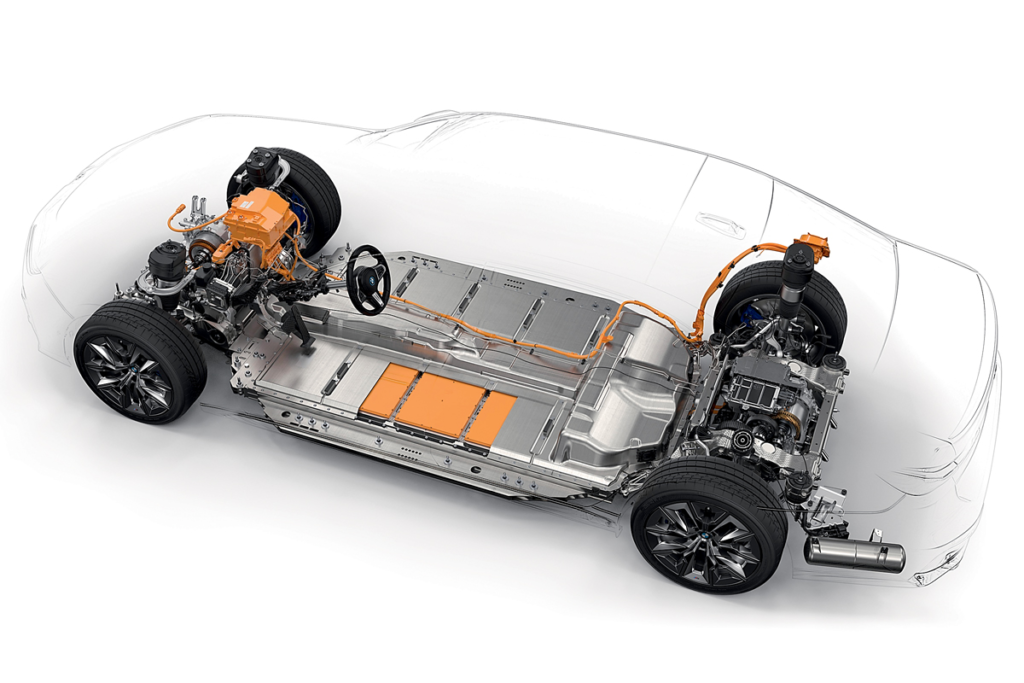
Yeni “7 Serisi”ndeki dikkat çekici bir değişiklik, dış kapı kollarının olmaması. Elektrikli kilit düğmesini gizleyen gizli cepleri takdir ediyorum. Çıkıntılı kolların bir tasarım hatası olduğu bir çağda, bu çözüm geri çekilebilir mekanizmalara tercih edilir ve neyse ki burada hiçbir şey donmaya meyilli değil. Bu ceplerin yol kirini toplayacağı yönündeki endişelerim yersizdi; titizlikle tasarlanmış aerodinamikler sayesinde. Ve artık yaylı kolların dokunsal hissini yaşayamasanız veya kinematiğini gözlemleyemeseniz de, bu tür ayrıntılar klasik otomobil etkileşimlerinden hoşlananlar için. Sadece düğmeye basın, motor vızıltısını duyun ve içeri hoş geldiniz.
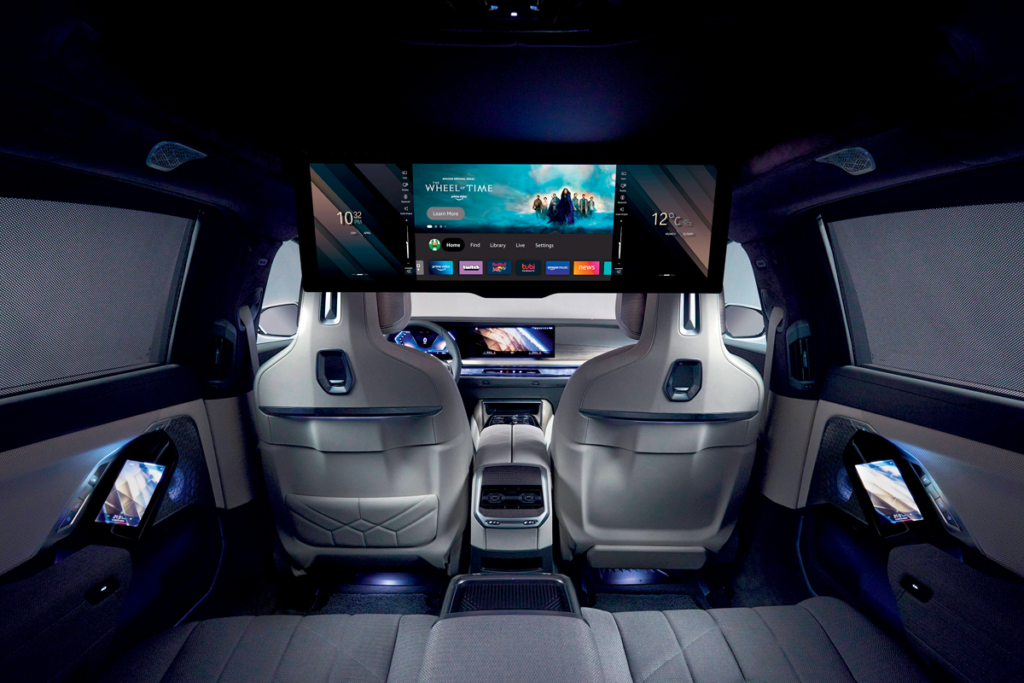
İsteğe bağlı katlanabilir 31 inçlik “televizyon” belki de yalnızca basın bültenindeki güzel çekimler için gereklidir. Pratik önemi şüphelidir.
G70’in iç mekanı, bayide sergilenen önceki “7 Serisi” G11 ile karşılaştırıldığında, BMW’nin imzası olan kokudan yoksundur. G70, her zamanki deri zenginliği yerine belirgin bir teknolojik aroma sunar ve döşeme daha çok kauçuk benzeri bir his verir. Bunun nedeni, Kaliningrad’ın “paket” sedanlarında ve crossover’larında bulunan Sensatec malzemesine benzer sentetik bir deri olan Veganza’dır. Elbette, hakiki deri ve hatta kaşmir ekler hala mevcut seçeneklerdir. “740”ın arka koltuğu, ayarlamalardan yoksun, dikkat çekici derecede basittir. İlginç bir şekilde, yükseltilmiş oturma yerlerine sahip önceki “7 Serisi” modellerinin aksine, yeni düzen Mercedes’in tasarımına daha yakındır, özellikle puflar ve masaj cihazları olan ayrı koltuklar seçerseniz fark edilir. Buna rağmen, bacaklar ve başlar için bolca alan vardır ve standart koltuklar bile rahat bir konumlandırma sunar. Yukarıda, büyük bir tavan penceresi ambiyansa katkıda bulunur ve yolcuların arkaya yaslandıklarında arka sütunun kenarının arkasına gizlice saklanmalarına olanak tanır.
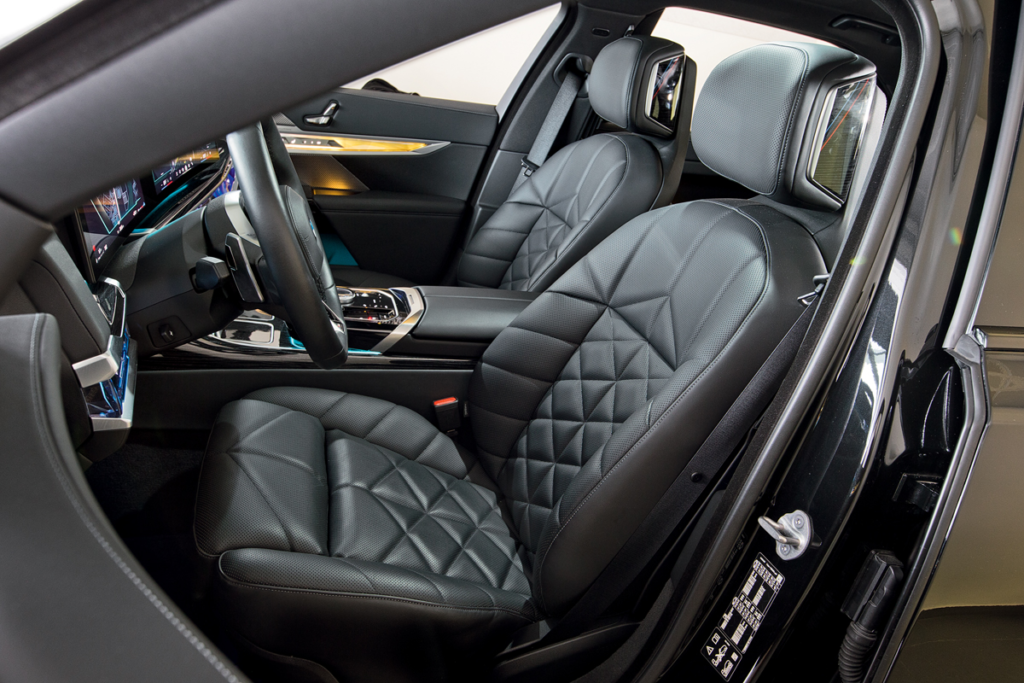
Yeni koltuk düzeninde herkes farklı bir şey görüyor. Dolgu beklenenden daha yumuşak ve ayarlamalar rahatsız edici. Tipik Mercedes düğmelerinin kapıya geçici olarak taşınması bile (BMW’de böyle bir karar nasıl onaylandı?) koltuk pozisyonunda önemli bir değişikliğe neden oluyor ve tüm hassas ayarlamalar menüde gizli.
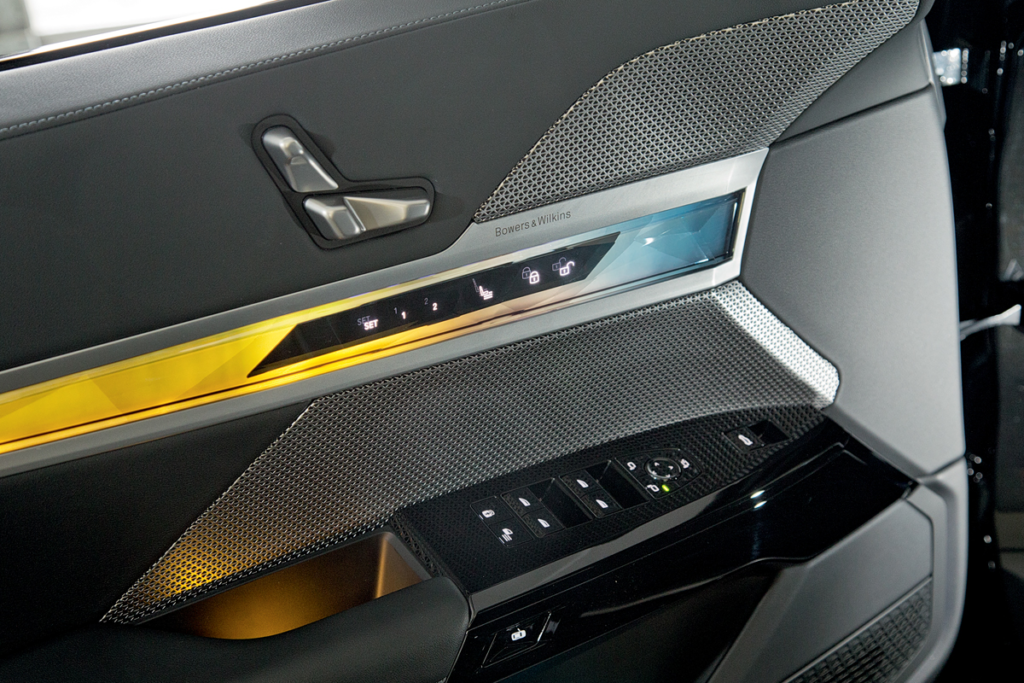
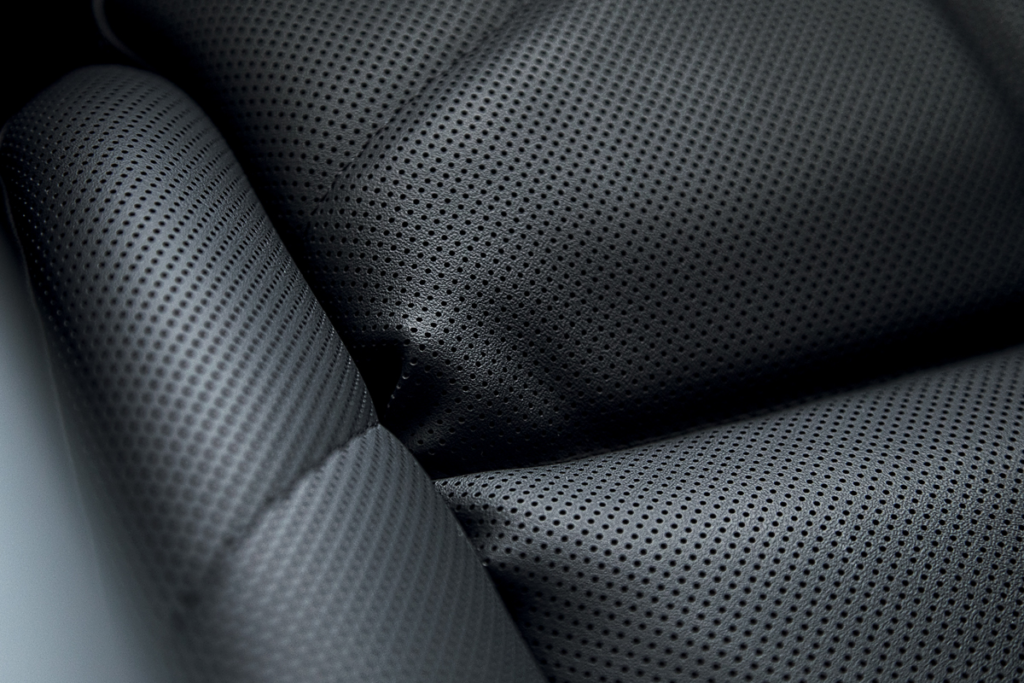
Minder uzatıcısındaki dağınık kıvrımlar böyle bir arabada yersizdir.
Dokuz yıl önce, daha önceki “7 Serisi”nin merkezi kol dayanağına entegre edilmiş tabletten etkilendiğimi açıkça hatırlıyorum. O hantal Samsung Galaxy Tab 4, iç mekan için gerçek bir kontrol merkezi görevi görüyordu: mikro iklimi ayarlıyor, panjurları geri çekiyor, kabini aydınlatıyordu. Şimdi, araçta kapı kolu tabanlarına yerleştirilmiş iki tablet var; önceki modelin önemli kollarının olmaması göz önüne alındığında, bu kullanışlı özelliğin boşa gitmemesini sağlayan ustaca bir yükseltme. Başlangıçta, iç mekan teslimat alanında soğuk ve cansız, hatta belki de türev gibi geldi; özellikle kapıdaki çok tanıdık Mercedes koltuk ayarlama kontrollerini fark ettiğinizde. Ancak, kapsamlı bir test sürüşünden sonra, G70, özellikle mevcut Mercedes S-Class V223 serisiyle karşılaştırıldığında, belirgin şekilde daha çağdaş görünüyor. Bu BMW gerçekten gelecekten gelen bir araba gibi hissettiriyor. Önceki iç mekan tasarımlarına düşkünlüğüm olsa da, E32 nesline dayanan tasarım konseptlerinin amansız evrimi, hızla gelişen bir pazarda çok önemli.
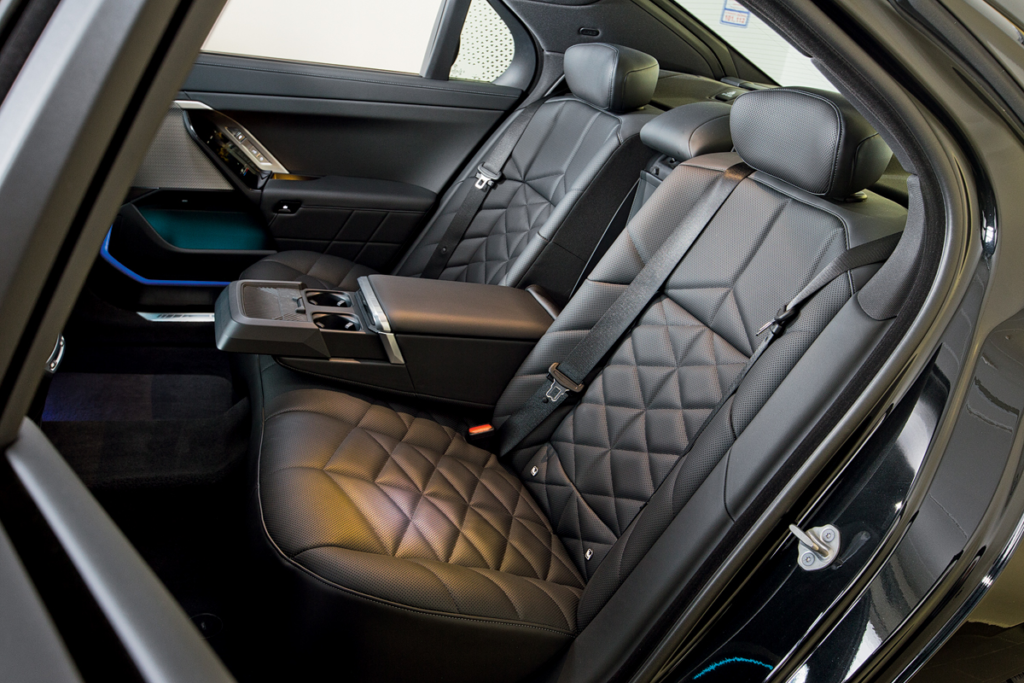
Temel arka koltukta herhangi bir ayar yok ama oldukça rahat.
“Geleceğe” hitap etmek genellikle kullanıcı arayüzlerini yeniden tasarlamak anlamına gelir: “Modlarım”daki şasi modlarının neredeyse yarısı gösterge ekranını birkaç eğik yola sıkıştırır. OS8 arayüzüyle yeni iDrive multimedya sistemi, BMW’nin fütüristik iç dünyasını parlak bir şekilde sergiliyor. Döner kadran kalırken, işlevselliği eski hissettiriyor; yeterince düzgün dönüyor, ancak yanal hareketler beklenmedik şekilde dirençli ve sınırlı. Neyse ki, dokunmatik ekran duyarlı ve doğru.
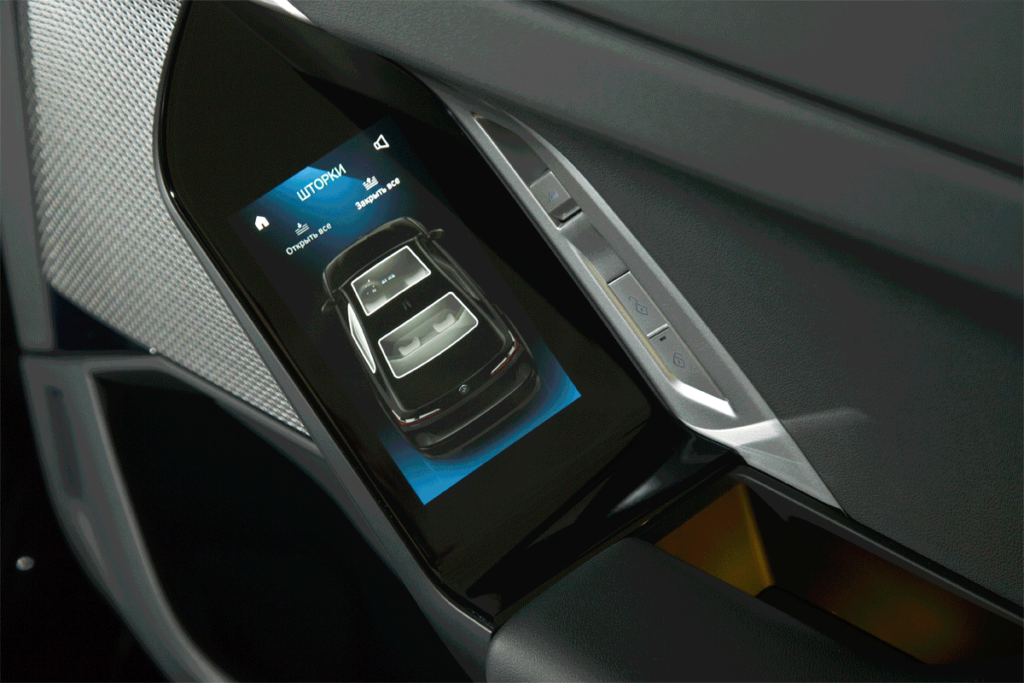
İç mekan tasarımcılarının bir keşfi: Arka kapıların döşemesinde dokunmatik ekranlar. Çinli şirketlerin bunu ne zaman kopyalayacağını merak ediyorum?
Menü, uygulama sekmeleriyle bir akıllı telefon düzenini taklit ediyor ve bu, çok sayıda aynı simge arasında kaybolan hassas koltuk ayarlamalarını içeriyor; bu, bir masa çekmecesinde eski bir Zopo telefonuna rastlamak kadar eski bir düzen. Ancak, tescilli sürüş modları ve ana ekran, ayrıntılara dikkat edilerek tasarlanmış ve denge kontrolünün nasıl devre dışı bırakılacağını keşfetmeye yönelik keşfi teşvik ediyor; bu yalnızca bir araç arayüzü değil, aynı zamanda bir dijital sanat eseri.
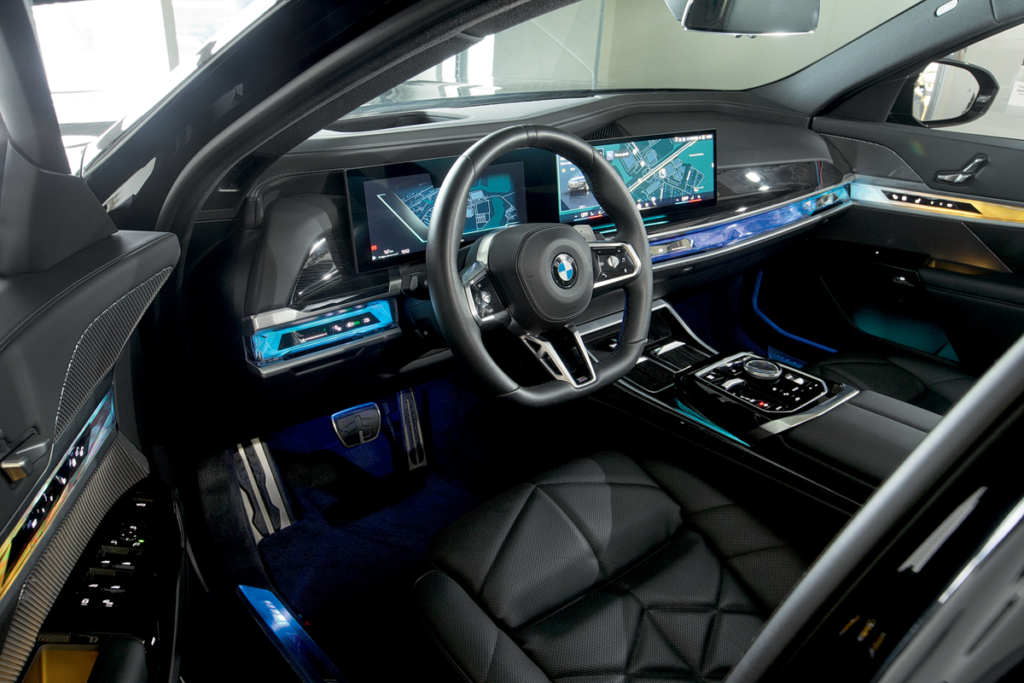
Ekranlar baskın değil; göz, fasetli bir kabuğun ve yeni bir direksiyonun altındaki renkli bir akış tarafından yakalanıyor. Her zamanki BMW atmosferi, zemine monte edilmiş bir gaz pedalına sahip pedal ünitesi tarafından da yaratılıyor.
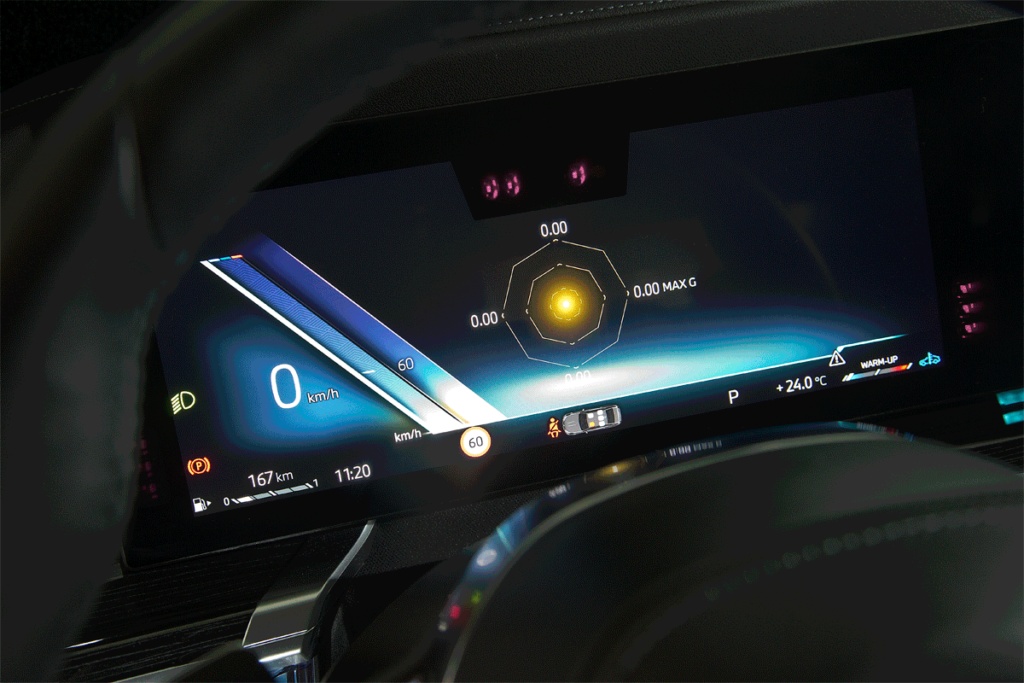
Köşeye sıkıştırılmış hız göstergesi şaşırtıcı derecede kolay okunuyor. Alt satırda her zaman yakıt rezervi ve soğutma sıvısının sıcaklığı hakkında bilgi gösteriliyor.
Gerçekten de, Rahatlatıcı, İfade Edici ve Dijital Sanat ayarları benzersiz grafiklerle kendilerini farklılaştırıyor. Renkli soyut tasarımlar her ekranı dolduruyor ve kabinin önünü saran geniş bir iç aydınlatma hattıyla uyum sağlıyor; ne yazık ki arka yolcular bu görsel şölenden mahrum kalıyor. Pencere panjurlarının ve tavan penceresi ayarlarının entegrasyonu sürükleyici deneyimi tamamlıyor. Harika bir şekilde çalışıyor: BMW M6 GT3 tabanlı sanat otomobili üzerindeki çalışmalarıyla tanınan Çinli sanatçı Cao Fei, otomobilin iç mekanlarına taze, sanatsal bir hava katmış. Bu, Asya araçlarında sıklıkla bulunan ortam doğa seslerine ve “yaz ortası gecesi rüyalarına” sofistike bir selam.
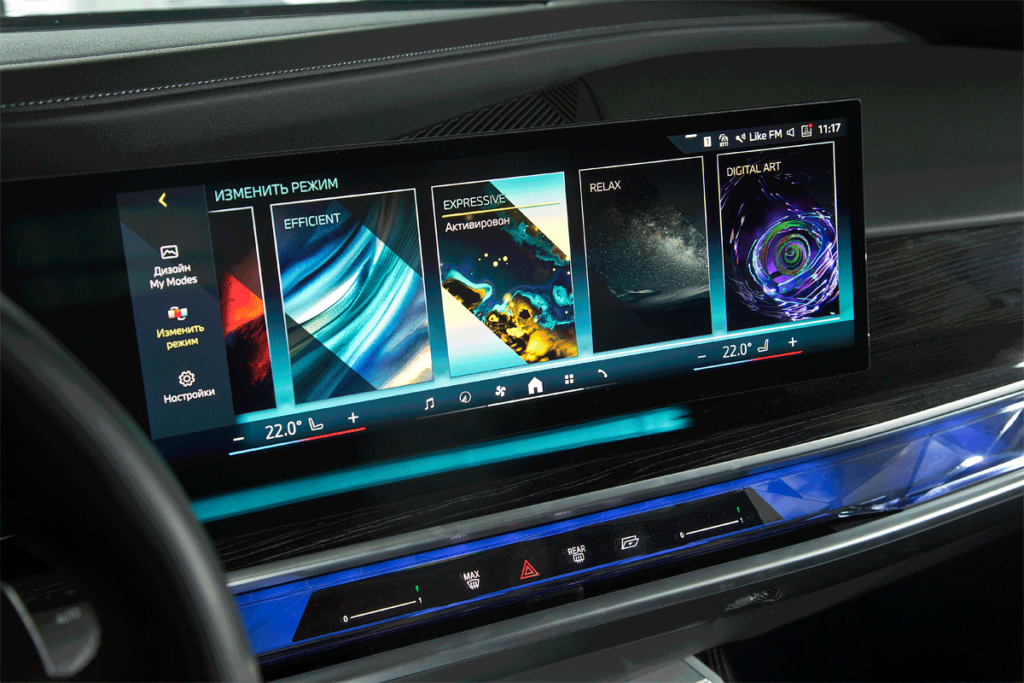
Yeni multimedya sisteminin en büyük dezavantajı, merkezi tüneldeki döner kadranı kullanarak tam kontrol sağlamanın verdiği rahatsızlıktır. Grafikler ve ekran çözünürlüğü Çin arabalarından sonra güven vericidir.
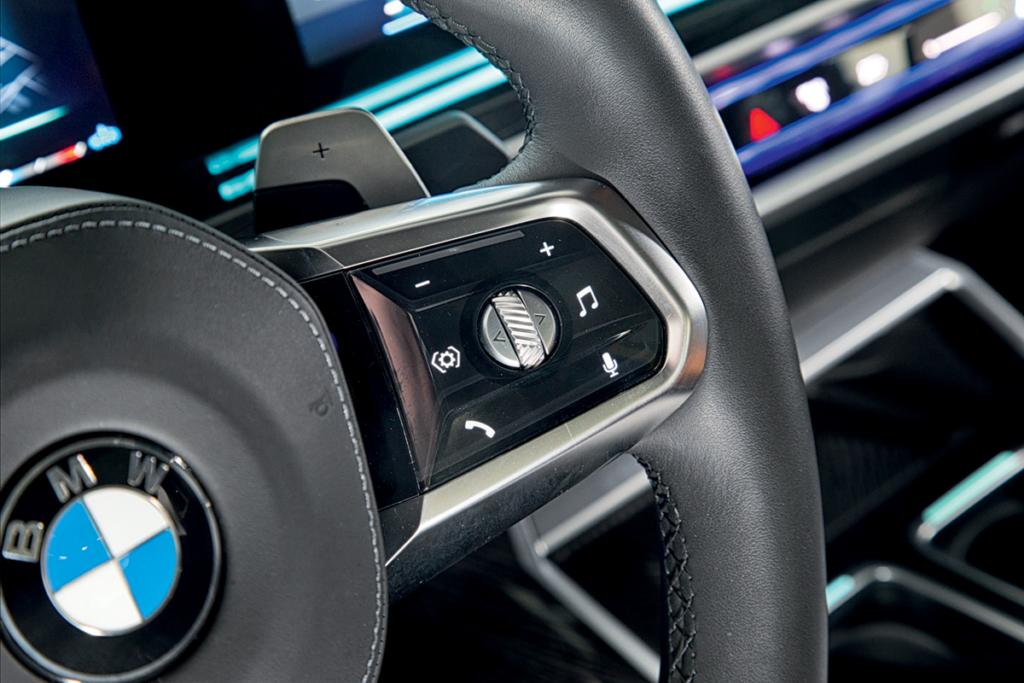
Tırtıklı tekerlekler sadece dönmüyor, aynı zamanda bir yandan diğer yana sallanıyor.
Yine de, acil bir soru var: denge sistemini nasıl kapatıyorsunuz?
Bu, baş tasarımcı Domagoj Dukec ve dış tasarımcı Sebastian Simm’in stilistik deneylerine rağmen, bunun tartışmasız bir şekilde bir BMW olmaya devam ettiğini doğrulamak için çok önemli. Markanın en büyük sedan ve SUV’larında bile ayırt edici özelliği, biraz eğlenceli drifte izin vermesidir. Genellikle, X7 bunu X3’ten daha iyi başarıyor ve “7 serisi” bunu “3 serisi”nden daha hassas bir şekilde yönetiyor. BMW 740d veya 340i ile virajlı bir kış yolunda drift yapmak arasında bir seçim yapmam gerekirse, hiç tereddüt etmeden yedinci seriyi seçerdim. Evet, biraz ağır ama gaz kelebeği girişlerine verdiği tepki ve virajlarda nötr yol tutuşu (tipik xDrive aşırı düzeltmelerinden uzak) örnek niteliğinde. Bariyerlerden gelen rafine parıltı, devasa krom burun deliklerinden yansıyor ve gerçekten de sofistike duruşunu tamamlıyor.
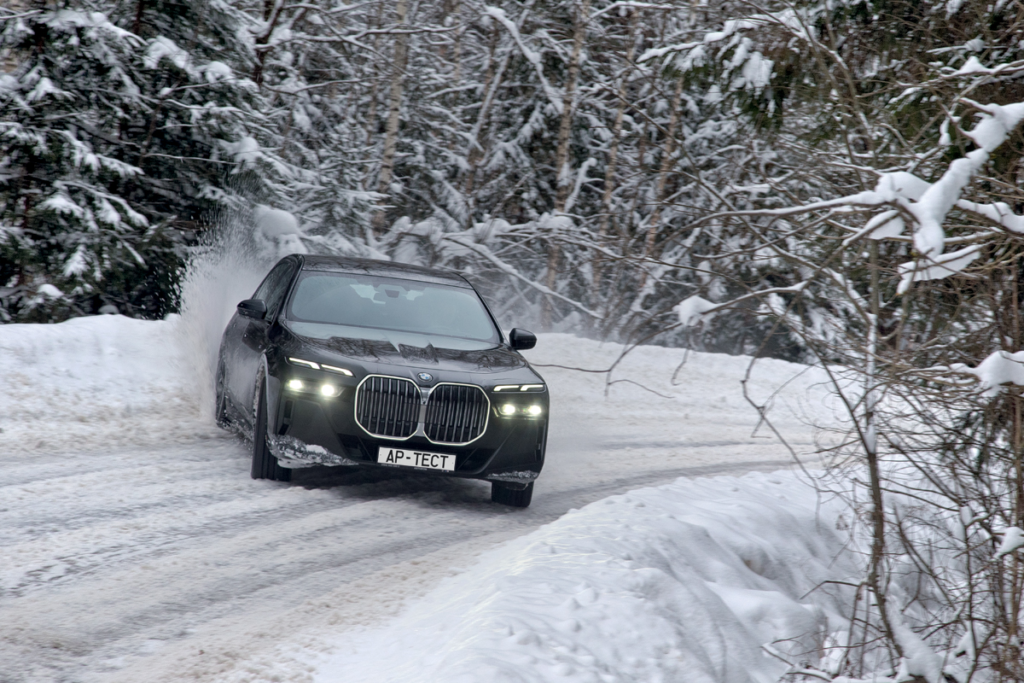
BMW 740d, özünde, lüks ve dinamik performansı bir araya getirerek sürükleyici bir sürüş deneyimi sunarak beklentileri yeniden tanımlıyor. Gelişmiş teknoloji, konfor ve ikonik BMW sürüş keyfinin birleşimi, onu sadece bir araç değil, aynı zamanda miras ve yenilik arasındaki çizgide ustaca gezinen tekerlekler üzerindeki bir ifade haline getiriyor.
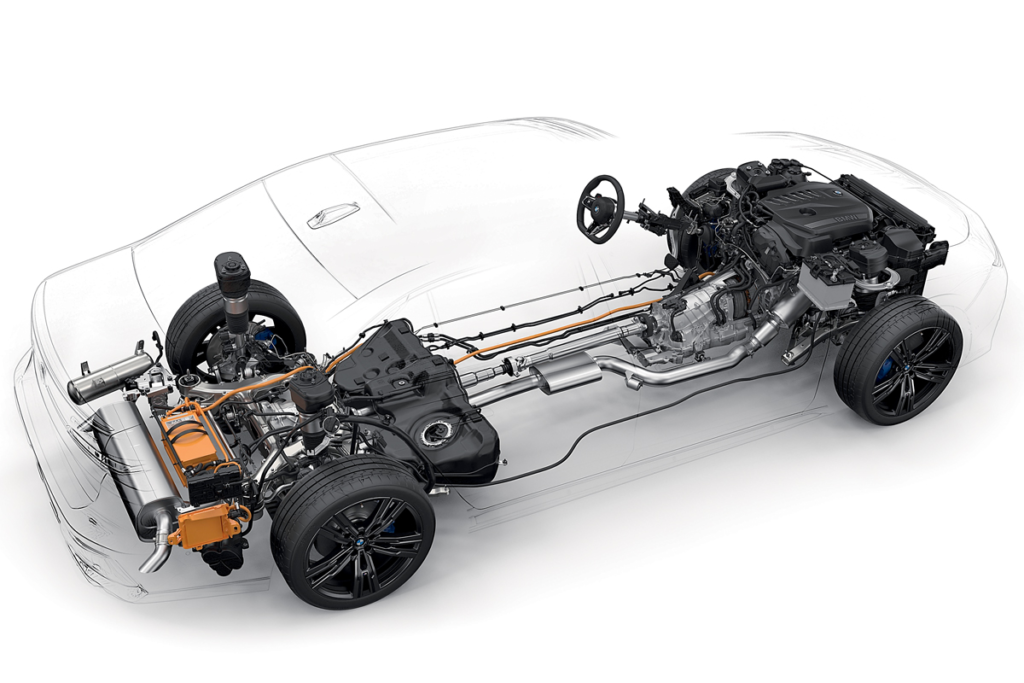
Şasi seçici olarak güncellendi. Ön çift salıncaklı ve arka çok bağlantılı süspansiyon korundu. Hava yayları gövdeyi 20 mm yükseltebilir ve yerden yüksekliği neredeyse 200 mm’ye çıkarır. Ön alt şasinin sertliği artırıldı ve arkada artık daha iyi konfor için hidrolik yataklar var. Aktif dengeleyicilerin motorları artık 48 voltluk bir elektrik sistemiyle çalıştırılıyor (bileşenleri turuncuya boyanmış).
BMW 740d’nin sürüş deneyimi gerçekten beklentileri aşıyor. Hatta temel dizel motor bile 150 km/s’ye kadar övgüye değer dinamikler sağlıyor. Testlerimizde, araç 100 km/s’ye 6,2 saniyede çıktı, vaat edilen 5,8 saniyeden biraz daha düşük. Dikkat çekici bir şekilde, motor dizel için alışılmadık bir şekilde 5600 rpm’ye kadar çıkıyor ve sanki hala güç rezervleri varmış gibi zahmetsizce çalışıyor. Sekiz ileri otomatik şanzıman kusursuz bir şekilde çalışıyor ve daha da önemlisi, benzer bir güç aktarma organına sahip “3 serisi”nin aksine, “7 serisi” trafik ışıklarında yumuşak bir duruş sağlıyor. Elektrikli destekle donatılmış fren pedalı özellikle iletişimsel değil ancak uzun mesafesi düşük hızlarda yanlış adımları önlüyor. Ayrıca, zorunlu start-stop sistemiyle ilgili hiçbir zaman sorun yaşamadım; kusursuz.
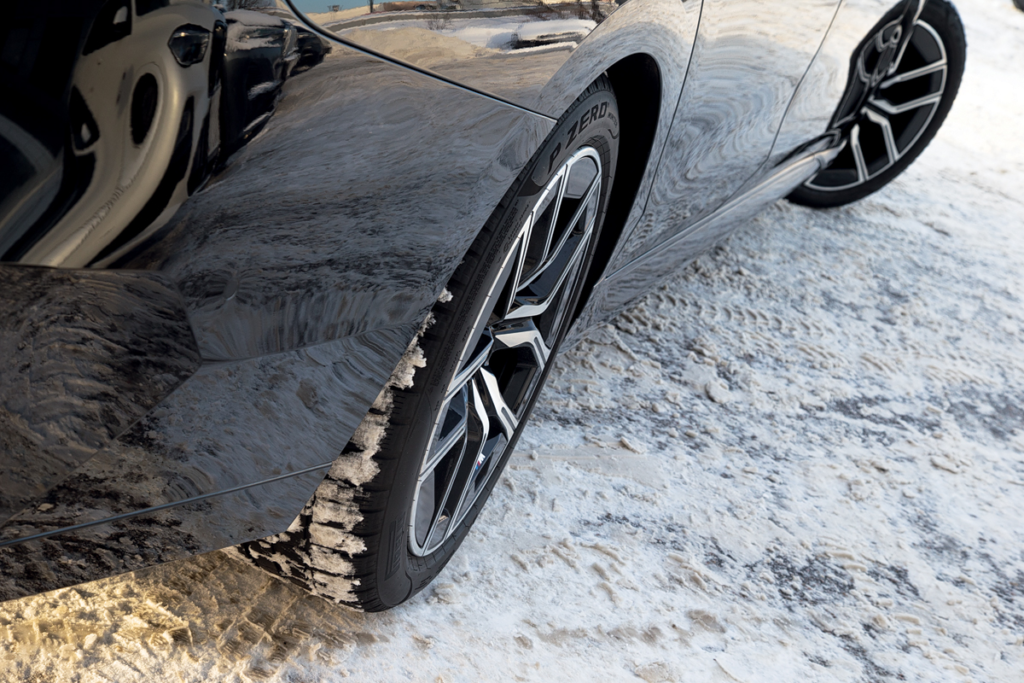
Arka tekerlekler için 3,5 derecelik dönüş açısı mevcut standartlara göre mütevazıdır. Ancak dönüş çapını 0,8 m azaltmaya yeter.
CLAR platformu, süspansiyonun düzenini ve ana unsurlarını koruyarak kalır. Ön çift salıncaklı ve arka beş bağlantılı hala aktif dengeleyicilerle geliştirilebilir ve dört tekerlekten yönlendirme artık tüm yedinci seri sedanlarda standarttır; muhtemelen karbon fiberin malzeme listesinden çıkarılmasının bir telafisidir. Önceki “7 serisi”nin merkezi sütunundaki o Karbon Çekirdek rozetleri? Artık bunlar modası geçmiş durumda ve gövde yapısında kompozit malzeme yok. Ayrıca, Münih “eklem” esnekliği açısından Mercedes’i takip etmedi; arka tekerleklerin maksimum sapma açısı, S-sınıfındaki 10 dereceyle karşılaştırıldığında sadece 3,5 derece. Pratik açıdan, bu yeterli olduğunu kanıtlıyor ve manevra kabiliyeti sorunları yok.
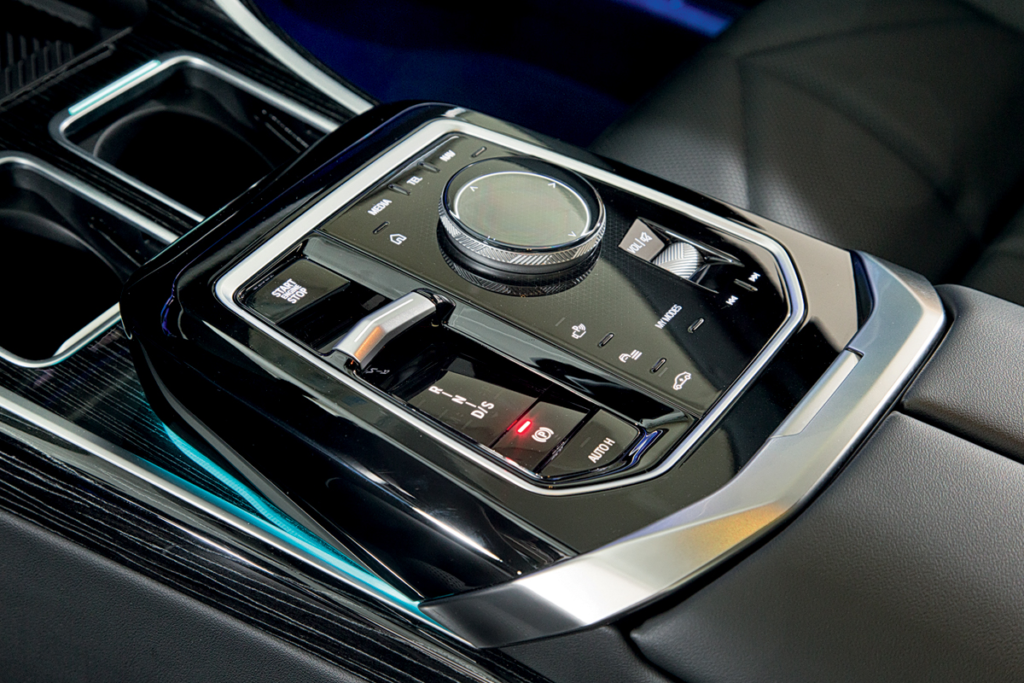
Şanzıman joystick’i zar zor fark edilen bir çıkıntıya dönüşmüş. Büyük medya kontrol kadranı ele iyi oturuyor, ancak yan hareketler için efor çok yüksek.
Başlangıçta, yol tutuşundan etkilendim. Daha keskin bir tepki verme isteğim olsa da, direksiyon tepkileri bana çeviklikte sınıfında lider olan önceki “7 serisi”ni canlı bir şekilde hatırlattı. Ancak, daha yavaş modlarda hoş olan şey, daha yüksek hızlarda bir yük haline geliyor. 170 km/s’nin altında seyahat etmek, modern bir yönetici otomobili için gerçekten aşırı olarak kabul edilebilir mi? Bu hızlarda, sedanla bağlantı zayıflıyor, şerit değiştirmeler gerginleşiyor, yolcular sessizleşiyor ve avuç içleri terliyor. Bu his kış lastiklerine bağlanabilir ve “7 serisi”nin yaz yollarında belirgin şekilde daha iyi yol tutuşu sağlayacağını tahmin ediyorum.
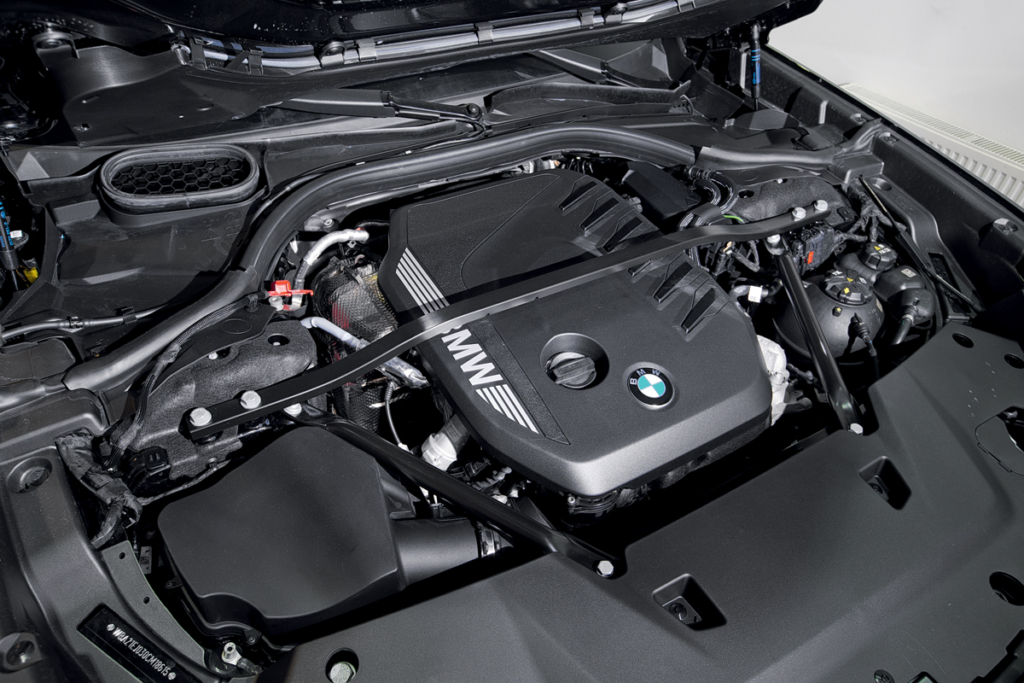
B57 dizel önemli ölçüde yükseltildi: alüminyum yerine çelik pistonlar, 2500 bara kadar enjeksiyon basıncına sahip yeni yakıt enjektörleri. Durma noktasından hızlı bir kalkış sağlayan 48 voltluk marş jeneratörü, gaz pedalına basıldığında tipik modern dizel gecikmesini ortadan kaldırmaya yardımcı olur.
Ya da belki de araba gerçekten çok hızlı? 150 km/s’nin ötesinde, motor beklenmedik şekilde buhar kaybediyor ve hızlanma uyuşuk hissettiriyor. Birkaç dakika önce, güçlü bir dizel motora sahip son teknoloji bir aracı kullanıyordunuz ve şimdi daha küçük turbo motorlara sahip hatchback’ler bile sizi geçiyor. Ancak, BMW 740d ve Mercedes S 350 d’nin dinamiklerini karşılaştırdığımızda, ikincisi sürekli geride kalıyor. Hibrit bir sistemle yüklenen daha güçlü benzinli versiyonları veya dışarıdan yalnızca küçük ayrıntılarla ayırt edilen elektrikli i7 sedan’ı test etmek ilgimi çekiyor.
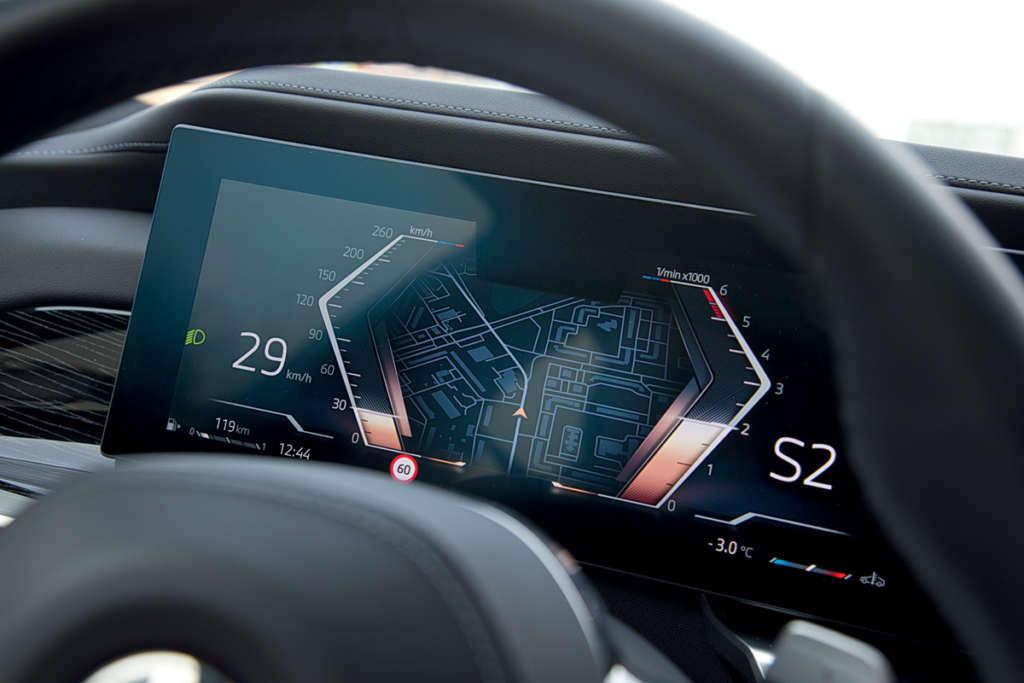
Standart gösterge ekranı (ilk slayt) ve ikinci slayt—aktif otopilotla gerçek zamanlı video yayını. Sadece ellerinizi direksiyondan kısa bir süre uzak tutamazsınız (BMW, fark edilir kar izlerine rağmen mükemmel bir şekilde sürer), aynı zamanda ön camdan değil, ekrana da bakabilirsiniz.
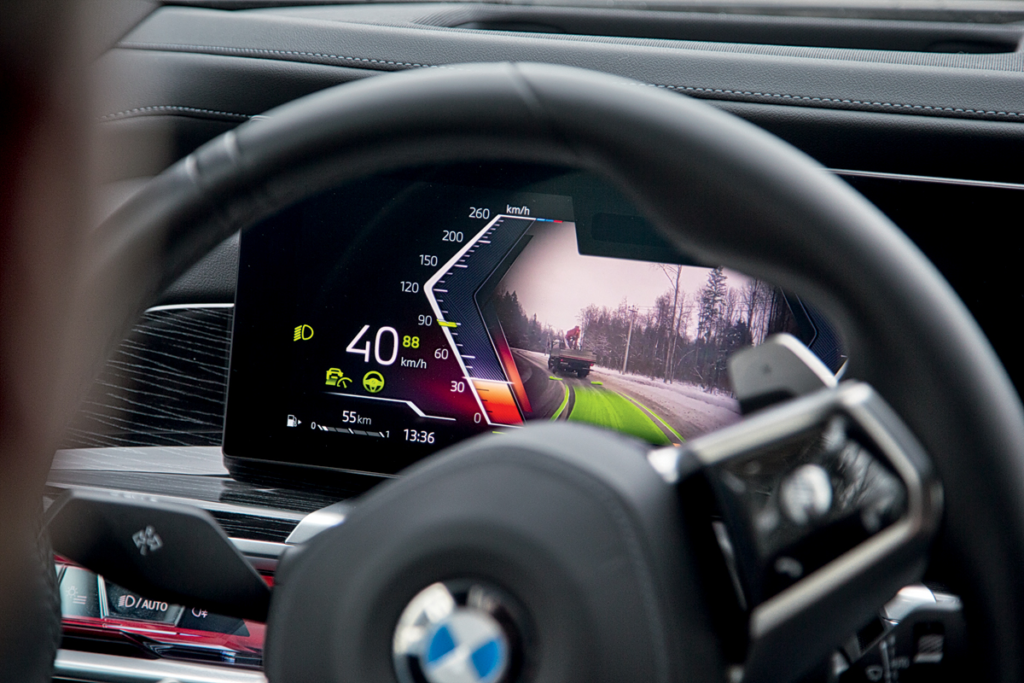
Peki daha mı sessiz? Bu “7 serisi”nin tek ama kalın pencereleri var ve bence kabini dış seslerden yeterince korumuyor. Motor gürültüsü, tam gazda bile minimum düzeyde ve rölantide hafif bir titreşim sadece direksiyon simidinden algılanabiliyor ve değiştirilemez start-stop sistemi devreye girdiğinde kayboluyor. Yine de rüzgar ve geçen kamyonlar duyulabiliyor; S-sınıfının saran sessizliğinden eser yok.
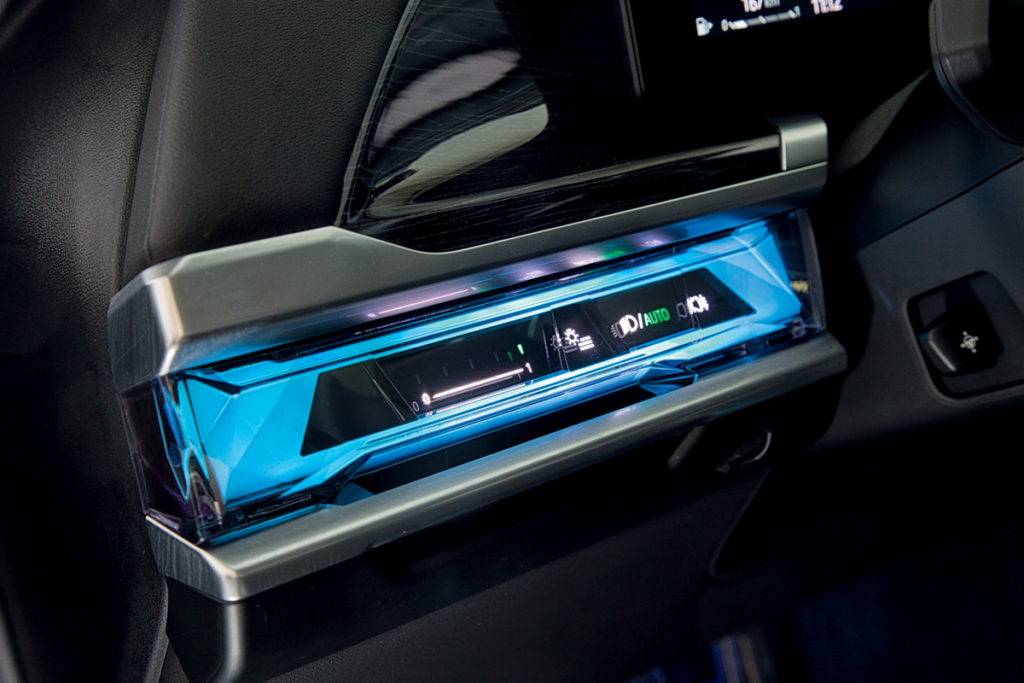
BMW’nizde hala yuvarlak bir ışık kontrol düğmesi varsa, ona bir veda edin. Bundan sonra, düğmeler ve sensörlerle öyle olacak.
Başka bir notta, “yırtık trambolin” etkisini deneyimlemek benzersiz bir şekilde keyiflidir: Yukarı doğru yumuşak bir şekilde kaldırılırsınız ancak inişte sert bir şekilde sarsılırsınız. Uyarlanabilir amortisörler ve hava yayları, konfor ve spor modları arasında sınırlı bir seçim sunar. Basın bültenine göre, Relax ve Digital Art ayarları da süspansiyon davranışını etkiler, ancak Yaroslav Tsyplyonkov ve ben bunu konfor ayarından ayırt etmekte zorlandık. Çoğunlukla Comfort modunda sürdük, burada büyük sedan beklenmedik şekilde sert bir şekilde gidiyor ve aksi takdirde pürüzsüz bir yolda küçük kusurlara huysuzca tepki veriyor. Sürüşümde onur arıyorum ve Comfort modunda, havada süzülüyormuşum gibi hissetmeyi tercih ediyorum. G70’in bir dalga üzerinde giderken geçirdiği kısa havada asılı kalma aşaması keyifli, ancak gövde inişte neden bu kadar ani bir şekilde durmak zorunda? Yolun görünümüne göre sürüş yumuşaklığındaki farklılık kafa karıştırıcı. Garip bir şekilde, hem sürüş hem de akustik konfor, arkaya kıyasla önde belirgin şekilde üstün.
Bu nasıl olabilir? Bu teknolojilerde neredeyse on yıl önce ustalaşmamışlar mıydı, amortisör tedarikçilerini değiştirmemişler miydi ve adaptif algoritmaları geliştirmemişler miydi? Gerçekten de, önceki “7 serisi” F01’den hatırlanan sert sarsıntılar ve darbeler yok, ancak orta dalgalanmalardaki fark edilir tümsekler cesaret kırıcı. İki yıllık bir derecelendirme testinde çeşitli yol koşullarında kapsamlı sürüşten sonra bile Mercedes S-sınıfında böyle bir rahatsızlık hatırlamıyorum. Ve Moskova’nın Üçüncü Taşıma Halkası’nın daha sert eklemlerinde ve engellerinde “7 serisi”ne meydan okumadık bile. M-Adaptive süspansiyonla deneyim nasıl olacak? Hoş olmayabileceğinden şüpheleniyorum.
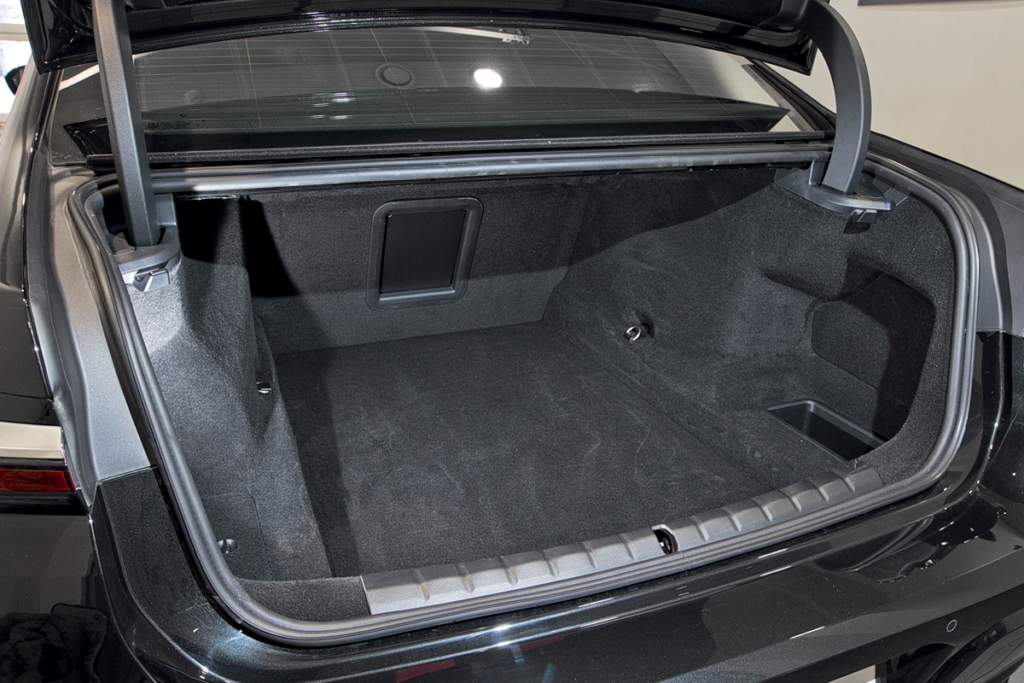
Tekerlek kemerlerinin boyutları büyüdü, yükleme yüksekliği de büyüdü. Bagaj hacmi (pasaport 540 L) ve kaplama kalitesi önceki seviyede kaldı.
Belki de yeni “7 serisi” için yeterli eleştiri taslağı hazırladım, buzlu Zikra’da izole edildi. Bir zamanlar tartışılmaz kabul edilen otomotiv standartlarının ne kadar hızlı düştüğü şaşırtıcı. Artık eski fiyatlarının iki katı hatta üç katı olan üst düzey Alman modelleri neredeyse gereksiz hale geldi, önceki sahipleri ise daha önce bilinmeyen Çin markalarını tercih ediyor. Yine de, kusurlarına rağmen, BMW G70 “7 serisi” sürdüğüm tüm Çin arabalarından üstün olmaya devam ediyor.
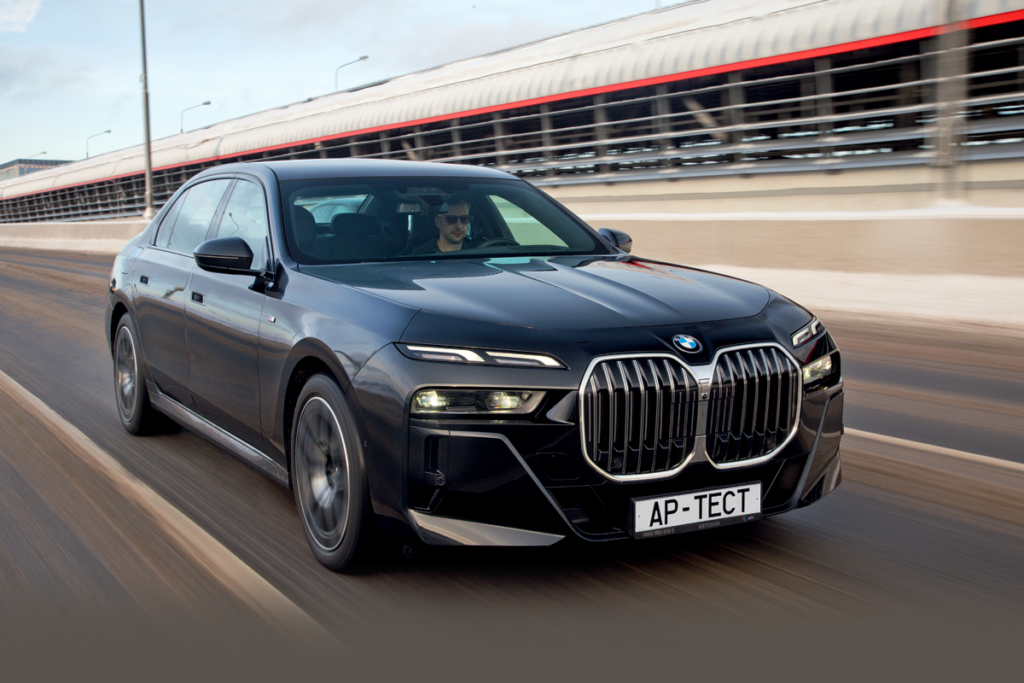
Alman mühendisliğinin geçmişten kalma bir kalıntı olduğunu düşünenler için, içiniz rahat olsun. COVID-19 duraklamaları, Çin pazarı etkisinin yükselişi ve küresel pazardaki önemli değişimlerle geçen beş çalkantılı yıl boyunca geliştirilen G70, kalıcı kalitenin bir kanıtı olarak duruyor. Tanıdık BMW geçmişini ve henüz keşfedilmemiş bir geleceği birleştiriyor. Örneğin, Mercedes S-sınıfı satışları geçen yıl %18 düşerken, bu “7 serisi”nin popülerlik kazanması için bir fırsat sunuyor. Yine de, yerel üreticilerin bu şirketler için en büyük pazar olan Çin’de önemli ilerlemeler kaydettiğinin de sinyalini veriyor. Bana göre, G70 bu yeni pazar dinamiklerine oldukça iyi uyum sağladı. Neyse ki, denge sistemi hala devre dışı kalıyor ve bu şık avcının yolda güzelce kaymasını sağlıyor.
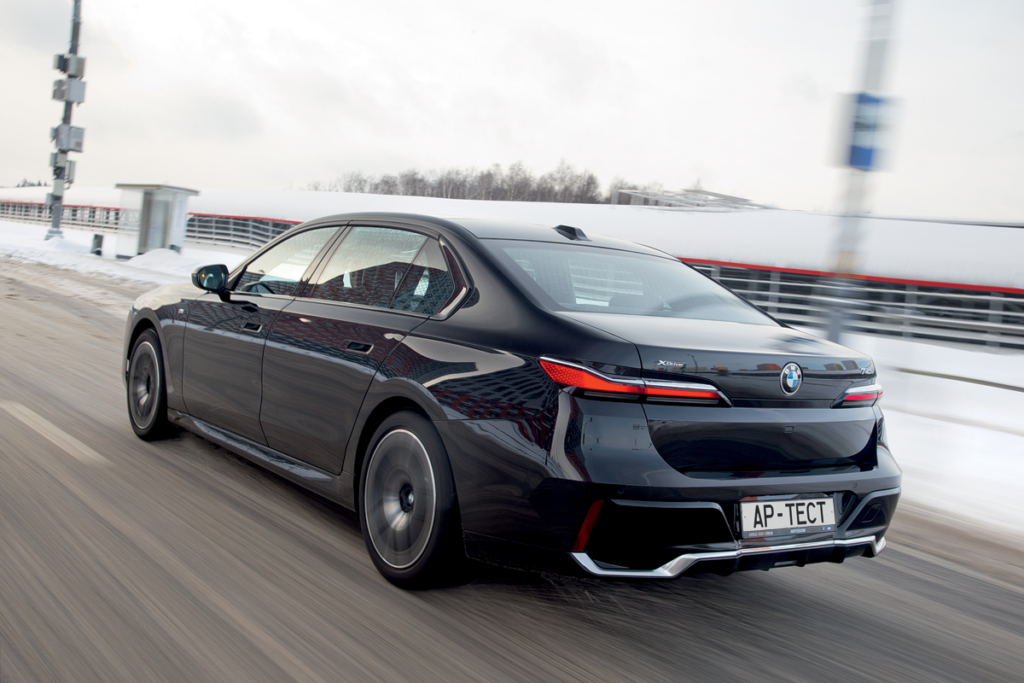
Bu, bagaj kapağında değil tamponda plaka bulunan ilk BMW 7 serisidir. Kapağın üst kenarı da eskisinden belirgin şekilde daha yüksektir.
İster uzun zamandır BMW tutkunu olun, ister lüks sedan pazarındaki seçenekleri araştırın, G70 geleneksel BMW performansının ileriye dönük yeniliklerle etkileyici bir karışımını sunar. Bu sadece bir otomobilden daha fazlasıdır; BMW’nin lüks sürüşün geleceğini nerede gördüğünün bir ifadesidir ve bu da onu hem sürüş tutkunları hem de teknoloji meraklıları için büyüleyici bir model haline getirir.
| Kategori | Şartname |
|---|---|
| Otomobil | Yeni BMW 740d xDrive |
| Gövde Tipi | Dört kapılı sedan |
| Boyutlar (mm) | Uzunluk: 5391 Genişlik: 1950 Yükseklik: 1544 Dingil mesafesi: 3215 Parça ön/arka: 1662 / 1684 |
| Boş Ağırlık (kg) | 2180 |
| Brüt Ağırlık (kg) | 2895 |
| Gövde Hacmi (L) | 540 |
| Motor Tipi | Dizel, akü enjeksiyonlu ve çift turboşarjlı |
| Motor Yerleşimi | Ön, boyuna |
| Silindir Konfigürasyonu | 6 silindir, sıralı |
| Deplasman (cm³) | 2993 |
| Maksimum Güç | 4000 rpm’de 286 hp / 210 kW |
| Maksimum Tork | 1500—2500 rpm’de 650 Nm |
| Marş Motoru-Jeneratör Gücü | 18 beygir / 13 kW gücünde |
| Marş Jeneratörü Torku | 200 deniz mili |
| Güç Aktarma Organlarının En Yüksek Gücü | 299 beygir gücü / 220 kw gücünde |
| Güç Aktarma Organının En Yüksek Torku | 670 deniz mili |
| Iletim | Otomatik, 8 vitesli |
| Sürücü Tipi | Dört tekerlekten çekiş, ön aks tahrikinde çok diskli kavrama ile |
| Ön süspansiyon | Bağımsız, pnömatik, çift enine kollarda |
| Arka süspansiyon | Bağımsız, pnömatik, çoklu bağlantı |
| Lastik Ölçüleri | 245/50 R19 |
| Maksimum Hız (km/s) | 250 |
| Hızlanma 0—100 km/sa (s) | 5.8 |
| Yakıt Tüketimi (L/100 km) | Karışık |
| Devir | 6.8 |
| Yakıt Tankı Kapasitesi (L) | 74 |
| Yakıt Tipi | Mazot |
Fotoğraf: Dmitry Pitersky | BMW şirketi
Uzman grubu: Yaroslav Tsyplenkov
Bu bir çeviridir. Orijinal makaleyi buradan okuyabilirsiniz: Тест нового седана BMW 740d поколения G70: жив ли немецкий инжиниринг?

Yayımlanmış Ağustos 22, 2024 • Okuma süresi: 16 dakika

